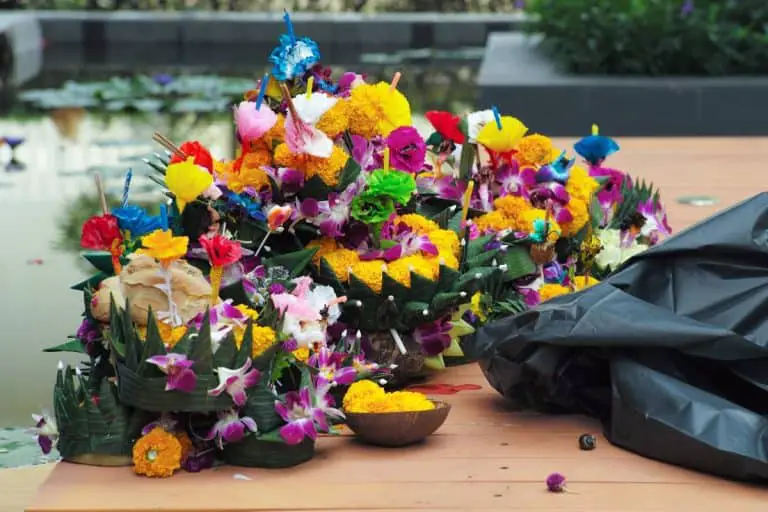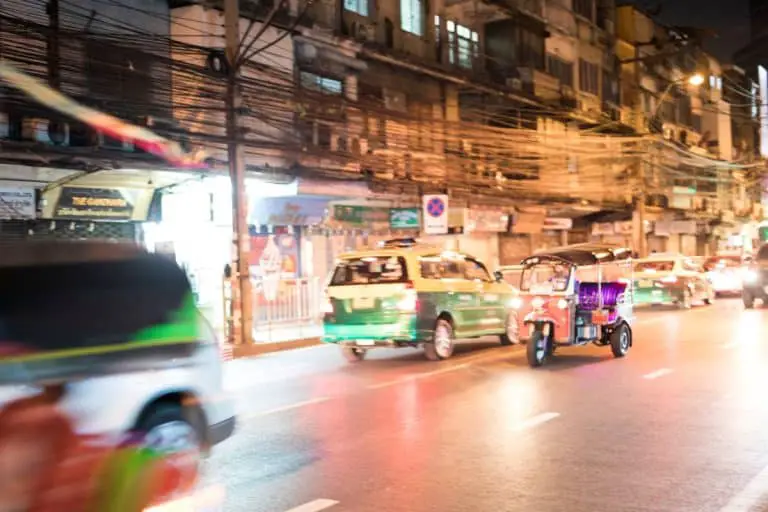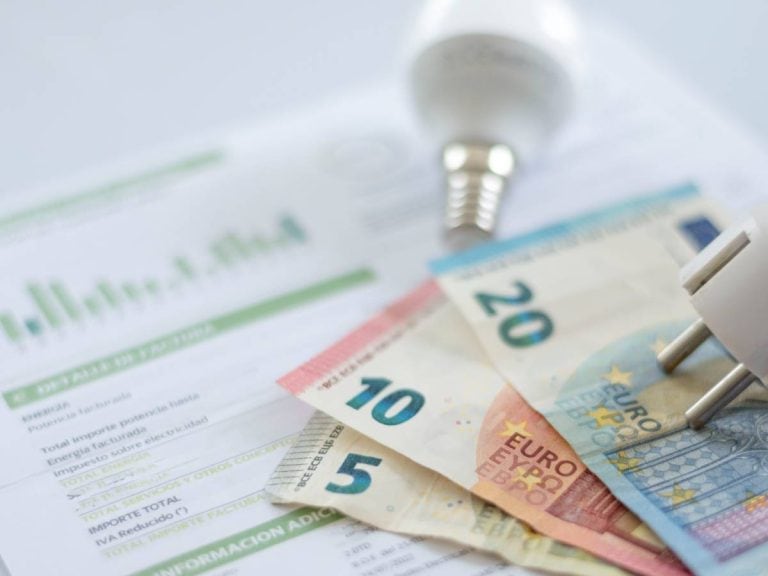7-Eleven Becomes Life Hub: Thailand’s Convenience Evolution
After 35 years of living in the United States, I thought I had a good understanding of convenience stores. Boy, was I wrong. When I moved to Thailand and started exploring this incredible country, I discovered something remarkable: 7-Eleven isn’t just a convenience store here—it’s become the beating heart of daily life. This true-life hub touches virtually every aspect of Thai society.
Walking through the bustling streets of Bangkok, Chiang Mai, or even smaller Thai towns, you’ll notice something extraordinary. There’s practically a 7-Eleven on every Thai street corner with over 13,000 stores opened in Thailand since the late 1980s. But what makes Thailand’s 7-Eleven story so fascinating isn’t just the sheer number of stores—it’s how 7-Eleven becomes life hub in these bright orange and green beacons that have transformed into comprehensive service centers serving as the backbone of modern Thai living.
Key Takeaways
- 7-Eleven has evolved beyond a simple convenience store to become Thailand’s essential life hub, serving over 11 million customers daily across 13,000+ locations
- Thailand’s 7-Eleven stores offer comprehensive services, including banking, bill payments, food delivery, and ready-to-eat meals available 24/7
- The convenience store chain has become so integrated into Thai culture that locals use “Seven” as synonymous with convenience stores nationwide
The Evolution from Store to Life Hub
When I first arrived in Thailand, I was amazed to discover that the first Thai 7-Eleven opened on 1 June 1989 on Patpong Road in Bangkok. What started as a simple convenience store concept has undergone a remarkable transformation. Today, these stores serve as multifunctional life hubs that go far beyond selling snacks and beverages.
The evolution has been dramatic. In Japan and Thailand, 7-Eleven sells medicine, accepts bill payments, and even offers banking services. This expansion of services represents a fundamental shift in how convenience stores operate, making them integral to daily life rather than just pit stops for quick purchases.
More Than Convenience: Essential Daily Services
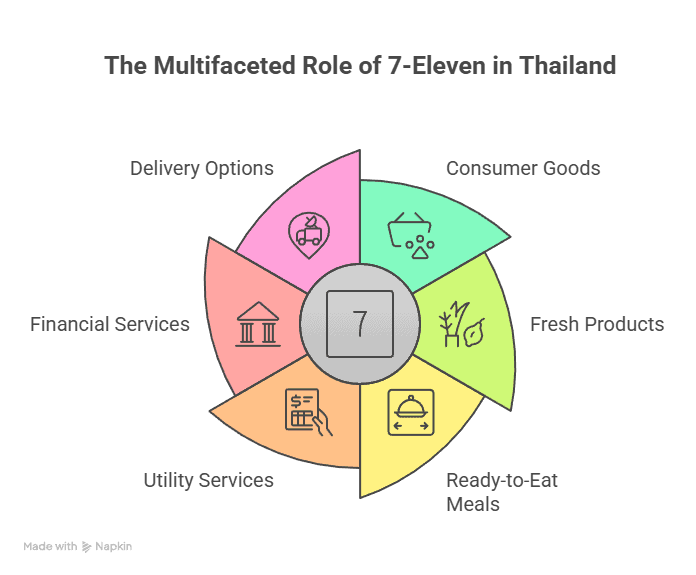
What struck me most about Thailand’s 7-Eleven stores is their comprehensive service offering. These life hubs provide essential services that would typically require visiting multiple locations. Integrated convenience service providing products and services in various forms, offline, online and home delivery. This includes distribution of necessary consumer goods in daily life, offering a large variety of fresh products, ready-to-eat meals, fruits, vegetables and beverages.
The stores have evolved to meet the changing needs of Thai society. You can pay utility bills, top up mobile phone credits, purchase insurance, and even handle banking transactions. It’s like having a mini town center packed into a compact retail space that’s open 24 hours a day.
A Cultural Phenomenon
The cultural impact of 7-Eleven in Thailand cannot be overstated. 7-Eleven became synonymous with convenience stores; stores are lined everywhere in the city, and the brand has become so deeply embedded in Thai culture that “convenience store” = “Sewen” is thought among Thai people.
This cultural integration is remarkable. In my travels across Asia, I’ve seen convenience stores in many countries, but nowhere have I witnessed such complete integration into the social fabric of daily life. The stores have become gathering places, meal destinations, and essential service centers all rolled into one.
The Food Revolution
One of the most impressive aspects of how 7-Eleven becomes life hub in Thailand is through food services. In a large store, refreshments such as porridge and noodles are cooked and sold on the spot, so we see that a busy businessman is eating at the Eat-in Corner as a lunch or a night snack.
The food offerings are extensive and localized. At 7-Eleven, you’ll find a range of quick, ready-to-eat meals like Pad Thai, fried rice, and curries. The famous toasted sandwiches alone come in at least 45+ different toasted sandwich flavours that rotate at 7-Eleven Thailand, making these stores legitimate dining destinations.
Meeting Modern Lifestyle Needs
The transformation of 7-Eleven into a life hub perfectly aligns with changing Thai lifestyles. The shift has occurred as shoppers in urban areas moved to an on-the-go lifestyle looking for quick solutions to save them time. This shift is particularly evident in Bangkok, where the population of young people who live alone live mainly in Bangkok is growing rapidly in Thailand.
These stores have adapted to serve single-person households and busy professionals who need everything from breakfast to banking services in one convenient location. The stores truly function as neighborhood hubs where people can accomplish multiple tasks during a single visit.
Technology and Innovation
Thailand’s 7-Eleven stores have embraced technological innovation to enhance their role as life hubs. Food and product delivery via mobile apps has become standard, allowing customers to access 7-Eleven services from home. Some locations even experiment with robots and automated checkout systems.
The digital integration extends beyond simple transactions. Customers can get pre-paid vouchers and gift cards like Netflix, Roblox, Playstation or Spotify, bridging the gap between physical and digital services seamlessly.
Economic Impact and Market Dominance
The numbers tell an impressive story of market dominance. Convenience stores in Thailand have one of the highest shares of the packaged grocery market of any country globally with over 1/3rd of all sales going through the channel. This level of market penetration demonstrates how thoroughly 7-Eleven has integrated into Thai consumer behavior.
The Global Significance
Thailand’s success with 7-Eleven as a life hub model is globally significant. Thailand has the second-largest number of 7-Elevens anywhere in the world (after Japan), and the transformation here has influenced convenience store operations across Southeast Asia.
The Thai model demonstrates how convenience stores can evolve beyond simple retail to become essential infrastructure for modern urban living. This evolution provides valuable insights for other developing markets looking to improve urban convenience and service accessibility.
Looking Forward
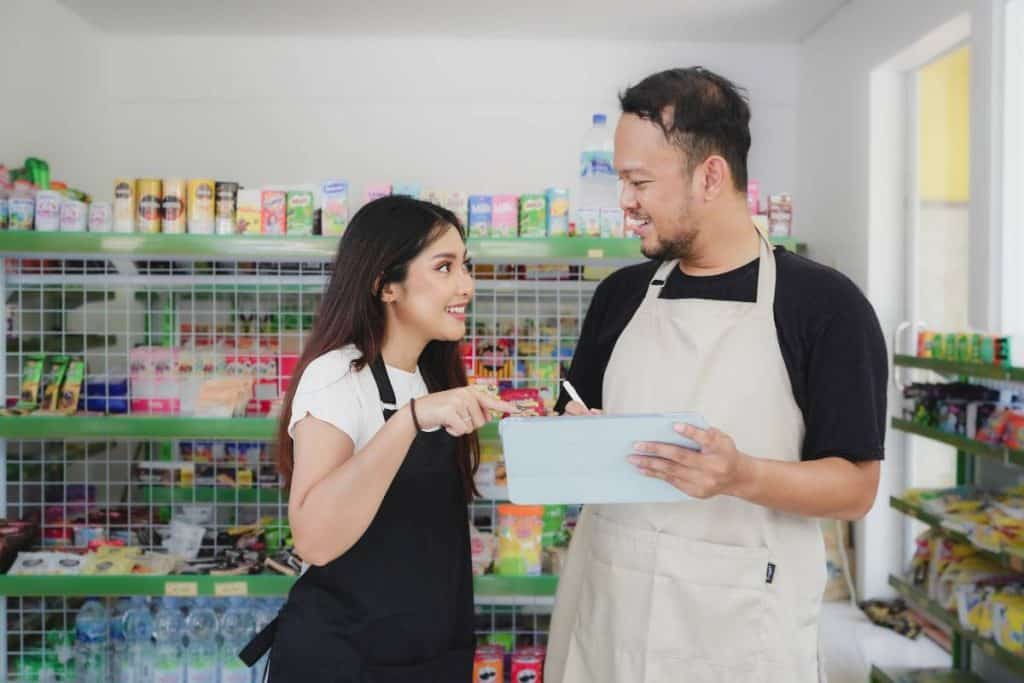
As Thailand continues to urbanize and digitize, the role of 7-Eleven as a life hub will likely expand further. The stores are already experimenting with expanded service offerings and technological integration, suggesting that their evolution is far from complete.
The success of this model in Thailand offers lessons for other countries in the region. As I’ve observed in my work with BetterLivingAsia, the convenience store as life hub concept could be particularly valuable in other Southeast Asian markets facing similar urbanization challenges.
Frequently Asked Questions
How many 7-Eleven stores are there in Thailand?
As of 2025, there are approximately 15,430 7-Eleven stores throughout Thailand, making it the second-largest 7-Eleven market globally after Japan.
What services can you get at 7-Eleven in Thailand besides shopping?
Thai 7-Eleven stores offer bill payments, banking services, mobile top-ups, insurance purchases, food delivery, and even medical supplies through their expanded service model.
Are 7-Eleven stores in Thailand open 24 hours?
Yes, most 7-Eleven stores in Thailand operate 24 hours a day, 7 days a week, though alcohol sales are restricted to specific periods (11 am-2 pm and 5 pm-midnight).
Why is 7-Eleven so popular in Thailand compared to other countries?
7-Eleven’s success in Thailand stems from its evolution into a comprehensive life hub offering essential services, localized food options, and convenience that perfectly match Thai urban lifestyle needs.
Can tourists use 7-Eleven services in Thailand?
Absolutely! Tourists can access most services, including purchases, mobile top-ups, and food options, though some banking services may require local identification.
How many 7-Eleven stores are there in Thailand?
Conclusion
Witnessing how 7-Eleven becomes life hub in Thailand has been one of the most fascinating aspects of my journey in Asia. These stores represent more than retail evolution—they’re a glimpse into how urban infrastructure can adapt to meet changing lifestyle needs efficiently and comprehensively.
If you’re considering a move to Thailand or simply want to understand modern Asian urban life better, I’d love to help you navigate this fascinating landscape. Connect with us today for more insights into life in Thailand and across Asia, or reach out to share your own 7-Eleven experiences in the region.



